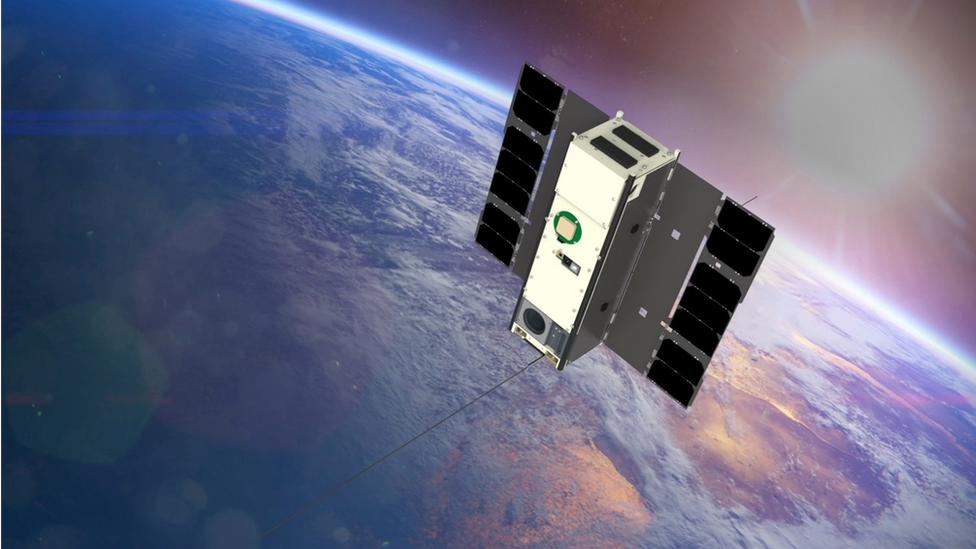Nasa 'smallsats' open up new planetary frontier
- Published

The IceCube smallsat was designed to study Earth, but upcoming missions would be despatched to other planetary bodies
Nasa is planning a series of small satellite missions that could open up new ways of exploring the Solar System.
James Green, head of planetary science at Nasa, told BBC News that the agency was investing in the technology and looking at how best it could be used.
Scientists studying these "smallsats" believe they have now proven their utility for cutting edge science.
They could be deployed from larger spacecraft to carry out targeted investigations, Dr Green explained.
These would complement the objectives of the main mission. Indeed, the Insight mission to Mars will test this approach, despatching two small satellites to collect data as the main lander descends to the Red Planet's surface.
But smallsats could also operate in constellations of 10 or many more.
"We're thinking about some other cubesat concepts, not only at Mars, but at the Moon, at asteroids, at Venus," the director of Nasa's planetary science division told me here at the Lunar and Planetary Science Conference (LPSC), external in Texas.
Dr Green said: "There's an array of ideas that we're kicking around right now. So I think what we'll see in the next 10 or 15 years is that the smaller satellites will have their own way to be implemented in planetary science that will be very complementary and we'll get some exciting science from them."
These spacecraft typically weigh less than 180kg compared with several tonnes for the satellites commonly used for bigger, costlier planetary missions.
Dr Jim Green of Nasa explains why the agency is investing in "smallsat" missions.
"What we're seeing is a capability that we haven't really seen before in terms of small satellites that can do pretty good science at a much reduced cost compared to the big missions," Dr Steve Mackwell from the Universities Space Research Association (USRA) in Maryland told BBC News.
"The miniaturisation and new capabilities means that we can open up science to places that we would have had to send a larger mission, and as a result it may never have flown."
"We're really opening up the opportunity to look at the inner Solar System, to places like Venus and the Moon."
At a Nasa briefing here at the LPSC, external, Dr Green said sending miniature satellites to other planetary bodies had previously presented challenges: "The further you are away, you get power difficulties, communication difficulties. There's a number of problems that arise from that. But we shouldn't be afraid... we need to figure out what are the technologies we need to make them a viable set of missions."
Dr Mackwell cites a few advances that are already helping bridge the gap. "The propulsion systems are compact enough now to put them in places where they can get a ride and then manoeuvre to their ultimate destination," he explained.
Engineers are also demonstrating innovative ways to fold up solar panels into smallsats, in order to boost their capabilities.
He added: "These [spacecraft] aren't limited to orbital components, some of these smallsats could go down to the surface of a planet potentially. We've talked about Venus for smallsats to do exploration.
"It's difficult to do anything at Venus… it has a surface temperature of 470C and a surface pressure of 90 bars. So the risk associated with a large mission may be too high to absorb that, whereas with a small mission you can send them very capably."
Dr Steve Mackwell of USRA says small satellites could enable missions not possible before.
Progress is being made on the technology required to achieve this. Engineers at Nasa's Glenn Research Center recently demonstrated printed electronics that could operate for prolonged periods in the harsh conditions found on Venus, external.
Nasa's announcement on smallsats follows a 2016 report by the US National Academies, external that concluded that the technology platforms had demonstrated their ability to provide high value science.
Last year, Nasa put out a call for smallsat ideas, which drew 102 proposals from the planetary science community. The space agency considered missions costing up to $100m (£80m).
From this longlist, an initial 10 missions have been selected, two each for Venus, the Moon, asteroids, Mars and outer planets and icy bodies. But several more that didn't quite make the cut this time could be funded in the near future as Nasa expands its mission roster of smallsats.
Nasa largely escaped the large cuts made to other federal agencies for 2018 in President Trump's budget request announced late last week. Its budget was reduced by only 1% to $19.1 billion.
Follow Paul on Twitter., external